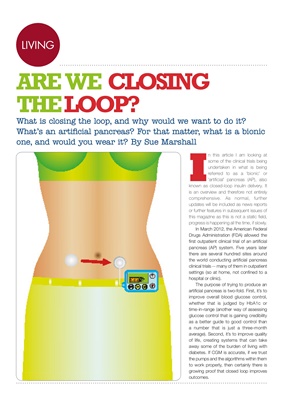
LIVINGLIVING
What is closing the loop, and why would we want to do it?
What's an artificial pancreas? For that matter, what is a bionic
one, and would you wear it? By Sue Marshall
ARE WE CLOSING
THE LOOP?
In this article I am looking at
some of the clinical trials being
undertaken in what is being
referred to as a 'bionic' or
'artificial' pancreas (AP), also
known as closed-loop insulin delivery. It
is an overview and therefore not entirely
comprehensive. As normal, further
updates will be included as news reports
or further features in subsequent issues of
this magazine as this is not a static field,
progress is happening all the time, if slowly.
In March 2012, the American Federal
Drugs Administration (FDA) allowed the
first outpatient clinical trial of an artificial
pancreas (AP) system. Five years later
there are several hundred sites around
the world conducting artificial pancreas
clinical trials -- many of them in outpatient
settings (so at home, not confined to a
hospital or clinic).
The purpose of trying to produce an
artificial pancreas is two-fold. First, it's to
improve overall blood glucose control,
whether that is judged by HbA1c or
time-in-range (another way of assessing
glucose control that is gaining credibility
as a better guide to good control than
a number that is just a three-month
average). Second, it's to improve quality
of life, creating systems that can take
away some of the burden of living with
diabetes. If CGM is accurate, if we trust
the pumps and the algorithms within them
to work properly, then certainly there is
growing proof that closed loop improves
outcomes.